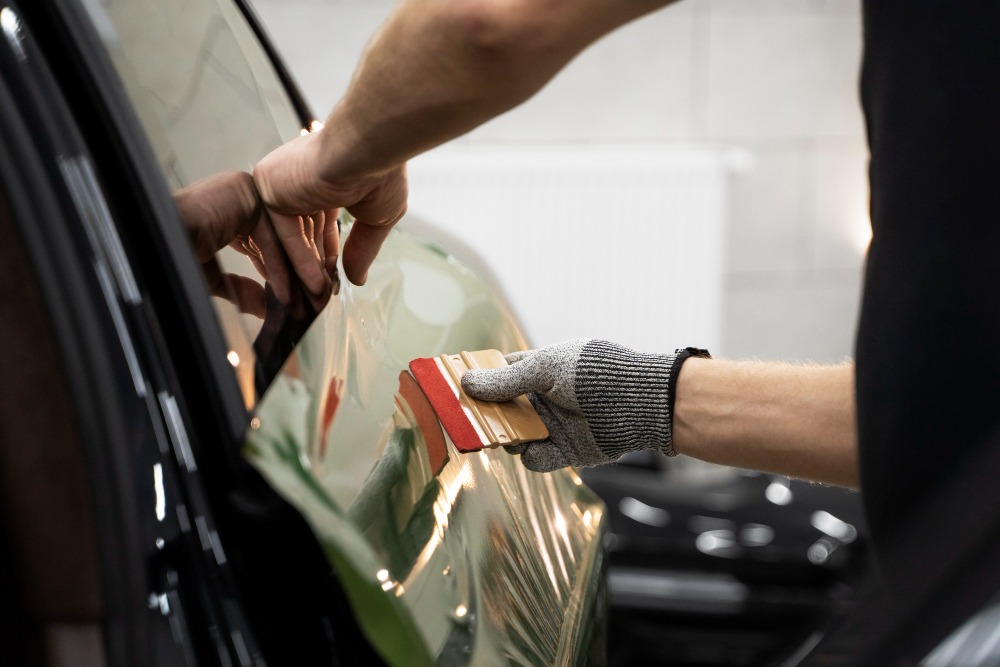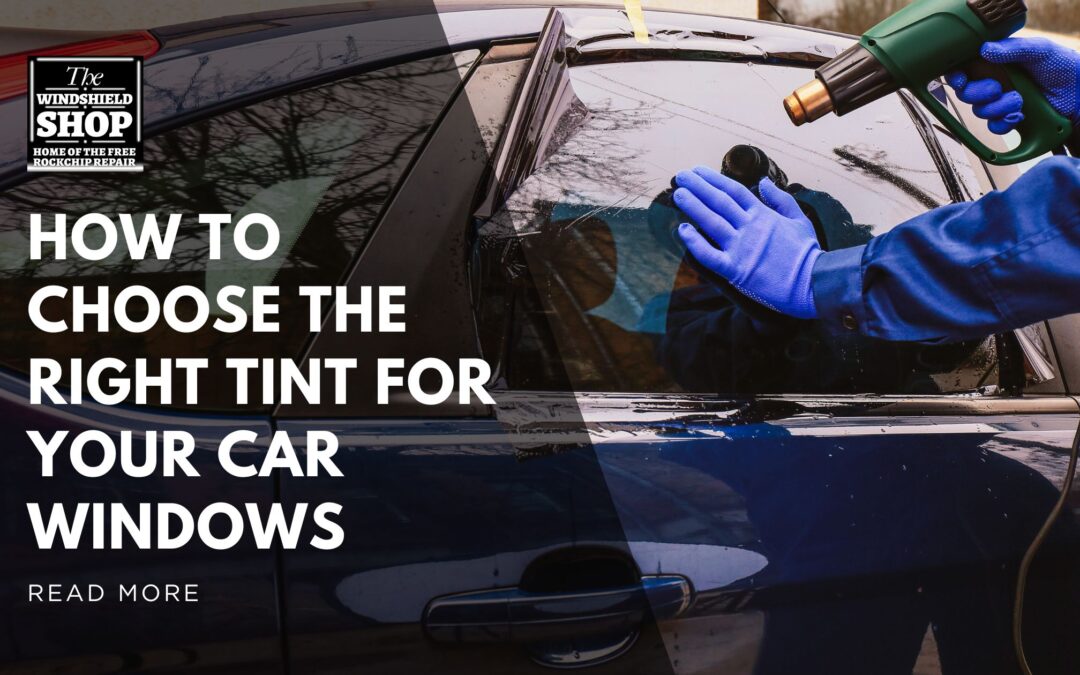- Understand your tinting goals, whether for UV protection, heat reduction, or aesthetics.
- Learn about different tint types (dyed, metalized, carbon, ceramic) and their benefits.
- Choose The Windshield Shop for expert installation and high-quality window tint that suits your needs.
Car window tinting offers much more than just an aesthetic upgrade to your vehicle. It serves practical purposes, including protecting your car’s interior from the sun’s harmful rays, improving privacy, and reducing heat buildup. Whether you’re looking to enhance the look of your car or make it more comfortable during hot weather, the right tint can provide a wide array of benefits.
Let’s explore some of the factors you should consider when choosing the best window tint for your car.
Understand the Different Types of Tints
When it comes to window tint, there’s no one-size-fits-all solution. The type of film used for tinting can greatly affect the performance and durability of the tint. There are a few primary types of window tint films to consider, each with its unique set of benefits.
Dyed Film
One of the most common and affordable options, dyed film consists of a layer of dye that absorbs heat. While it does provide a reduction in glare and offers privacy, its performance in blocking UV rays is less effective compared to other types of tint.
Additionally, over time, dyed films can fade and may lose their appearance, which means they might need to be replaced sooner than other types of tint.
Metalized Film
Metalized films are made with metallic particles embedded within the film. These films reflect light and heat, making them particularly effective at reducing the amount of heat that enters your car. Metalized tint is also durable and scratch-resistant, which contributes to a longer lifespan.
However, one drawback of metalized films is that they can interfere with electronic signals, such as GPS, cell phone, and radio reception, which could be a consideration if you rely on these devices while driving.
Carbon Film
A step up from dyed films, carbon films provide superior heat rejection while offering a sleek, matte finish. They don’t interfere with electronics and offer better UV protection than dyed films. Carbon films also resist fading over time, ensuring that your car’s windows retain their dark, uniform appearance. While carbon tints can be more expensive than dyed films, they offer excellent performance and durability.
Ceramic Film
Ceramic films are the most advanced type of window tint available. They provide exceptional heat rejection, block 99% of UV rays, and do not interfere with electronics. Ceramic tints are made with ceramic particles that are non-metallic, offering high durability without affecting your signal strength. While ceramic films are often the most expensive option, they are the most effective at providing both performance and long-term value.
Consider Your Privacy Needs
One of the most immediate benefits of window tinting is the increased privacy it offers. Tinted windows make it harder for people to see inside your car, whether you’re driving or parked. The level of privacy you get depends on the darkness of the tint, which is determined by the Visible Light Transmission (VLT) percentage.
What is VLT?
VLT is the percentage of light that passes through your car windows. For example, a 50% VLT means that 50% of the light is allowed through, while the other 50% is blocked. The lower the VLT percentage, the darker the window tint will appear.
For a subtle, slightly darker appearance without compromising too much visibility, a VLT of 50% or above may be ideal. A 35% VLT offers a more noticeable darkened effect, commonly used for rear side windows and rear windshields. If maximum privacy is your goal, a 20% or even 5% VLT (also known as limo tint) will provide the darkest possible look, though it can reduce visibility, especially at night.
Keep in mind that while darker tints offer increased privacy, they can also make it harder to see out of your windows. For the front windshield or front side windows, you may want to choose a lighter tint to maintain visibility while still achieving some degree of privacy.

Evaluate Heat Rejection and UV Protection
One of the main reasons car owners opt for window tinting is to reduce heat inside the vehicle. When your car is exposed to direct sunlight, the temperature inside can quickly rise, making it uncomfortable to get in or drive, especially in the summer months.
Certain window tints are specifically designed to block out infrared (IR) light, which is responsible for most of the heat buildup inside the car.
The effectiveness of the tint at rejecting heat can vary by the type of film used. Ceramic films, for example, are known for their superior heat rejection capabilities, making them an excellent choice for hot climates. Carbon and metalized films also provide significant heat reduction, but ceramic films tend to offer the best overall performance when it comes to blocking heat while still maintaining visibility.
Along with heat rejection, UV protection is another important factor to consider. The sun’s UV rays can cause skin damage, premature aging, and even increase the risk of skin cancer. The right window tint can block up to 99% of UV rays, offering protection for both your skin and your car’s interior.
Over time, UV exposure can cause your car’s upholstery to fade and crack. A quality tint will help preserve the interior of your vehicle and keep the temperature more comfortable, even on the hottest days.
Factor in Legal Requirements
Before choosing your car’s window tint, it’s important to be aware of the local laws and regulations that govern window tinting in your area. Different states and countries have varying restrictions on how dark your windows can be tinted, especially for the front windshield and side windows.
Some regions allow only specific VLT percentages for certain windows, while others prohibit the use of highly reflective tints.
Common tinting restrictions include:
- Front Windshield: Many areas only allow a small, tinted strip at the top of the windshield, while others may allow darker tints if you meet specific VLT requirements.
- Front Side Windows: These windows are often subject to stricter laws, with many states requiring a higher percentage of light to pass through than for rear side windows or the back windshield.
- Rear Side Windows and Rear Windshield: These windows typically have fewer restrictions and may allow for darker tints.
To avoid fines or being required to remove the tint, make sure you check your local laws before proceeding with installation. You can consult with a professional window tint installer to ensure your tinting complies with legal standards and avoid any complications.
Professional Installation vs. DIY Tinting
While it’s possible to apply window tint yourself using a DIY kit, professional installation is highly recommended for the best results. Applying window tint requires precise measurements and technique to avoid bubbles, wrinkles, or unevenness. If the tint is improperly applied, it can affect the overall appearance and may need to be replaced.
Professional installers have the necessary tools and expertise to ensure that the film is applied smoothly, without any imperfections. They are also familiar with local laws and can make sure your tint complies with all regulations. Additionally, most professional tint installers offer warranties on their work, giving you peace of mind that the job will be done correctly and that any issues will be addressed.
If you’re considering a DIY approach, keep in mind that the process can be time-consuming and may result in less-than-perfect results if you don’t have the right experience. While DIY kits are less expensive than professional installation, the potential for mistakes and the time it takes to apply the tint might not be worth the savings.
Window Tint Maintenance
Once your car windows are tinted, it’s important to maintain the tint to ensure its longevity. Most modern window tints are durable and resistant to fading, but proper care is essential to keep them looking great. Here are some tips for maintaining your window tint:
- Avoid rolling down your windows for at least a few days after installation to allow the tint to properly adhere to the glass.
- Use a soft microfiber cloth to clean the windows and avoid using abrasive materials that could scratch the tint.
- Avoid using ammonia-based cleaners, as they can break down the tint film over time. Instead, opt for a gentle, non-ammonia cleaner designed for tinted windows.
- Be careful with the edges of the tint, as peeling or lifting at the edges can lead to damage. If you notice any issues, address them promptly to prevent further wear.
Proper care can extend the life of your window tint and keep your car looking sharp.
Choosing the Right Tint for Your Car
Selecting the right window tint for your vehicle comes down to understanding your needs and preferences. Whether you prioritize privacy, heat reduction, UV protection, or aesthetics, there’s a tint that suits your lifestyle. By considering the different types of tints available, their heat and UV-blocking abilities, local regulations, and whether to go with professional installation or DIY, you can make a well-informed decision that will benefit both you and your car in the long run.
If you’re ready to enhance your driving experience with quality window tinting, professional guidance can help you find the best solution for your car and ensure that your tint is applied perfectly.
Transform your vehicle with expert window tinting at The Windshield Shop. Our professional installation offers privacy, heat reduction, and UV protection for your car. Contact us today!


